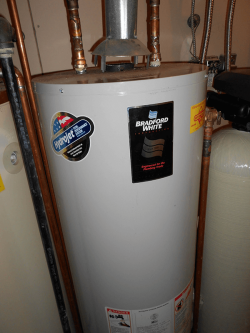Does My Water Heater Need An Expansion Tank?
In the Colorado Front Range, the simple answer to the question posed above, is ‘yes.’ While expansion tanks traditionally have been associated with hot water based home heating, i.e. central boiler systems with hot water baseboards and/or infloor tubing, they are now also standard equipment on all residential water heater installations and replacements.
So what’s the big deal? Let’s take a closer look at expansion tanks, and learn why they are used with water heaters, as well as with boilers.
What’s An Expansion Tank?
 An expansion tank is a relatively small water vessel placed inline in a closed hot water plumbing system (not open to atmospheric pressure) to help protect against excessive pressure due to the natural expansion of water as it’s heated up. The expansion tank provides the extra volume needed in the system during the heating phase. The type of expansion tank used with a water heater is called a ‘potable’ expansion tank, because its materials are rated for use with domestic drinking water. Standard central heat boiler systems typically use a non-potable rated expansion tank.
An expansion tank is a relatively small water vessel placed inline in a closed hot water plumbing system (not open to atmospheric pressure) to help protect against excessive pressure due to the natural expansion of water as it’s heated up. The expansion tank provides the extra volume needed in the system during the heating phase. The type of expansion tank used with a water heater is called a ‘potable’ expansion tank, because its materials are rated for use with domestic drinking water. Standard central heat boiler systems typically use a non-potable rated expansion tank.
The inside of a modern expansion tank contains a rubber diaphragm bladder, which stretches, expanding volume in the tank–and volume in the system–as hot water enters it during the heating process. As the system cools down, water exits the expansion tank, and the bladder contracts to eliminate the space that’s not needed under the cooler temperatures. The ‘dry space’ inside expansion tanks are pressurized with air to a level similar to rest of the system, and the air in the tank helps cushion the bladder as it expands and contracts.
Modern expansion tanks vary in size depending on the nature and size of the system they’re installed on, but they are typically much smaller than a standard water heater, on the order of two to four gallons in volume. They can typically be found located in line with cold water piping connected to the water heater or boiler.
Life Without An Expansion Tank?
Without somewhere for water to expand as it warms up, water pressure in a closed hot water plumbing system will climb steadily, until it reaches levels that could compromise critical components such as the glass lining or metal outer jacket of your water heater, as well as important valves located throughout your system. A properly functioning expansion tank can help prevent pressure-related leaks and parts failures from developing prematurely in your system–among these, failure of the hot water heater or storage tank, due to leakage!
Without an expansion tank, emergency relief valves in the system could actuate under high pressure conditions, dumping large amounts of hot water onto your mechanical room floor. Think of a tightly closed lid on a pot of boiling water! Whether the system will continue to operate properly under these conditions is not a given. In addition, expansion tanks can help reduce or eliminate ‘water hammer’ sounds or banging in your plumbing, as water valves in appliances like dishwashers and washing machines suddenly open and close.
Annual Maintenance Check
When annual service is performed on a boiler and/or water heater, an experienced service tech will always check the integrity of the existing expansion tank(s). If the system is missing an expansion tank, a savvy technician will discuss adding one to the system with you, and will provide a firm quote to perform that work.
In the Denver and Boulder, Colorado area, for questions about expansion tanks for your water heater or boiler, to schedule annual service or repairs–or for a free, low pressure quote for a new system, contact Save Home Heat Company for expert advice and service!




